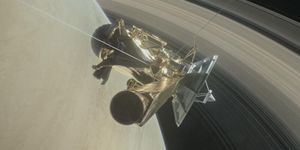This 3D-printed Device Can Help Spreading the Use of Acoustic Levitation
The acoustic levitation device suspends Styrofoam, water, coffee, and paper.
Credit: Asier Marzo
A team of mechanical engineers from the University of Bristol has developed an easier way for suspending small matter in the air: they built an acoustic levitator with readily accessible electronics and 3D-printed parts. According to their recent publication in Review of Scientific Instruments, this DIY-styled technology could be used in a variety of tasks where the containerless process is required. More importantly, it is so easy to set up that it is no longer limited to laboratories and factories.
Sound waves carry kinetic energy, which causes things to vibrate upon contact. Acoustic levitation harnesses the power of acoustic waves (usually ultrasound) to push objects and traps them in mid-air. Acoustic levitation is perfect for containerless processing, a procedure that becomes increasingly important in industry. In a typical setup, high-frequency sound waves are emitted from an emitter on top and get reflected by a reflector at the bottom. The interaction between newly emitted and reflected waves creates a field of so-called standing waves. Acoustic pressure points in the field can counteract the gravity to an extent and allow an object to suspend mid-air.
Acoustic levitation devices can be used to handle hazardous and sensitive materials like corrosive chemicals, blood and biological specimens and pharmaceuticals. Try to picture this: instead of having complex convey belts or many robots arms to move parts from one spot to another, an acoustic levitation device can do the same job, without any parts touching any surface.
Depending on the output energy of the acoustic waves, levitators can suspend objects of different weight, from a few grams and a couple of kilograms. A team of Chinese researchers has tried to trap insects like ants and beetles, as well as tadpoles and fish with their acoustic levitator. The levitation field was so strong that even the flying insects could not escape.
The University of Bristol team built their levitator using easy-to-find parts like parking sensors, a motor driver, a single board microcontroller and 3D-printed parts. They even developed an instruction pack for those wanting to build their DIY levitation device. According to their test of the levitator in a variety of conditions, it is safe to use, robust against temperature or humidity changes and can operate for a long period of time.
Dr. Asier Marzo from the University of Bristol commented on the motive behind the design: "Acoustic levitation has been explored in hundreds of studies for applications in pharmaceuticals, biology or biomaterials. It holds the promise of supporting innovative and ground-breaking processes. However, historically levitators have been restricted to a small number of research labs because they needed to be custom-made, carefully tuned and required high-voltage. Now, not only scientists but also students can build their own levitator at home or school to experiment and try new applications of acoustic levitation."
Scientists at Argonne National Laboratory have discovered a way to use sound waves to levitate individual droplets of solutions containing different pharmaceuticals.
Credit: Argonne National Laboratory
Source: phys.org/Review of Scientific Instruments









